Abstract
In this paper, a high-density gas–liquid discharge plasma is obtained combined with nanosecond pulse voltage and a floating electrode. The discharge images, the waveforms of pulse voltage and discharge current, and the optical emission spectra are recorded. Gas temperature and electron density are calculated by the optical emission spectra of N2 (C3Πu → B3Πg) and the Stark broadening of Hα, respectively. The emission intensities of N2 (C3Πu → B3Πg), (B2Σ → X2Π), OH (A2Σ → X2Π), O (3p5P → 3s5S0), He (3d3D → 3p3), gas temperature, and electron density are acquired by optical emission spectra to discuss plasma characteristics varying with spatial distribution, discharge gap, and gas flow rate. The spatial distributions of discharge characteristics, including gas temperature, electron density, and emission intensities of N2 (C3Πu → B3Πg), (B2Σ → X2Π), OH (A2Σ → X2Π), O (3p5P → 3s5S0), and He (3d3D → 3p3), are presented. It is found that a high-density discharge plasma with the electron density of 2.2 × 1015 cm−3 and low gas temperature close to room temperature is generated. While setting the discharge gap distance at 10 mm, the discharge area over liquid surface has the largest diameter of 20 mm; under the same conditions, electron density is in the order of 1015 cm−3, and gas temperature is approximately 330 K. In addition, the discharge plasma characteristics are not kept consistent in the axial direction, in which the emission intensities of (B2Σ → X2Π), N2 (C3Πu → B3Πg), OH (A2Σ → X2Π), and gas temperature increased near the liquid surface. As the discharge gap is enlarged, the gas temperature increases, whereas the electron density remains almost constant. Moreover, as the gas flow rate was turned up, the electron density increased and the gas temperature was kept constant at 320 K.
1. Introduction
Atmospheric pressure (AP) gas–liquid discharge plasma has been actively investigated for its promising application prospects in water purification [1,2,3], biomedicine [4,5,6], and materials processing [7,8,9]. However, random micro discharge channels occur easily which can lead to non-directed energy distribution leading to serious issues and adversely affecting industrial applications. Hence a stable gas–liquid discharge at AP is expected. Over the last two decades, various factors have been studied for improving discharge stability, including the electrode structures [10,11], the driving power supply [12,13], the working gases characteristic [14,15], and many other experimental parameters. In addition, the plasma characteristic could be different even under the same conditions [16], because it is influenced by electron transport. Thus, it is necessary to discuss the mechanism that leads to the change of the discharge mode, such as the glow to arc transition (GAT), which is a common result of thermal and electronic instability. Both of those instabilities are intensified by positive feedback via Joule heating [17]; more specifically, a slight increase in temperature can lead to a significant increase in vibrational–translational relaxation rate, which improves gas temperature further via their exponential relationship [18]. In addition, the heat release happens in a small volume that allows thermal instability to develop rapidly.
Nanosecond pulse voltage can be used to generate stable non-thermal plasma, where the fast-rising time can prevent the GAT effectively. Since the rising time of nanosecond pulse voltage is shorter than the character time of gas heating (in microsecond scale) [19], the increase in gas temperature is not obvious. When the pulse voltage is applied, the rapidly rising voltage pulse induces a high electric field, which promotes the occurrence of non-equilibrium plasma [20], and the electrical energy delivered in the plasma discharge is mainly deposited in the energetic electrons instead of heating the heavy particles. Therefore, the nanosecond pulse voltage can be employed to generate a stable gas–liquid discharge with high electron density and low gas temperature [21,22]. Herrmann et al. [23] studied the influences of peak voltage and discharge gap distance on pulsed discharge behavior over the liquid surface. Gromov et al. [24] reported the physical process at the gas–liquid interface in a single pulse mode and high-frequency burst. Xu et al. [25] compared the pulsed discharge plasma and sinusoidal discharge plasma, the results showing that nanosecond pulsed discharge plasma has lower gas temperature and higher efficiency of bacterial inactivation in liquid than that of the sinusoidal discharge plasma. Wang et al. [26] used bipolar nanosecond pulse power to obtain a gas–liquid discharge plasma with electron density in the order of 1015 cm−3 and gas temperature of 350 K. They studied it further and reported in [27] that the electron density can be elevated to the order of 1017 cm−3 for the transient to spark discharge, with a gas temperature of 380 K.
In addition, the floating electrode (FE), as a kind of independent structure between electrodes, shows the potential to improve the discharge plasma characteristics [28,29]. As Hu et al. [30] reported, the FE can influence the place of initial current density increase. Lee et al. [31] compared electric field intensity distributions in a plasma jet with and without the inner-FE. The results show that the removal of FE improves plasma reactivity and lowers gas breakdown voltage. Liu et al. [32] developed a diffuse-like discharge and studied the spatial electric field distribution when the FE is set. The report shows that the spatial electric field near the FE is advantageous for generating uniform-density plasma. But there are few studies on the gas–liquid discharge when FE is employed.
In this paper, with the employment of bipolar nanosecond pulse voltage, a kind of new electrode structure is used to attempt to obtain a stable discharge over the liquid surface. The electron structure is composed of a floating electrode and a hollow high voltage electron. A series of studies on the floating electrode gas–liquid discharge (FEGLD) is presented in this paper, including discharge images, electrical characteristics, optical emission spectra, plasma gas temperatures, and electron density. The spatial distribution characteristics of FEGLD are also carried out. Moreover, the interaction area between high density and low gas temperature at AP is expected to be enlarged by adjusting the discharge operation conditions. The influence on FEGLD by the discharge gap distance and gas flow rate is described in detail.
2. Experiment Setup
Figure 1a illustrates the experiment setup of FEGLD, comprising a discharge reactor, a nanosecond pulse power supply, the electrical characterization measurement system, and the optical emission spectra (OES) detection system. He (99.999%) is used as work gas. Figure 1b shows the diagram of the discharge reactor in which a stainless-steel hollow electrode inserts into PTFE. The floating electrode is fixed 2 mm below the end of the high voltage electrode. The bipolar nanosecond pulse power supply (DGM-40, 100 MHz, Dalian Power Supply Technology Co., Ltd., Dalian, China) provides pulse peak voltage which is adjustable in the range of 0–60 kV. A high voltage probe (Tektronix P6015A 1000×, 3.0 pF, 100 MΩ) and a current probe (Tektronix TCP312, bandwidth 100 MHz) are used to measure pulse voltage and discharge current, which are displayed on the oscilloscope (Tektronix, TDS5054B, 500 MHz). These compose the electrical characterization measurement system. The optical fiber and grating monochromator (Andor SR750i) are employed as the OES detection system.
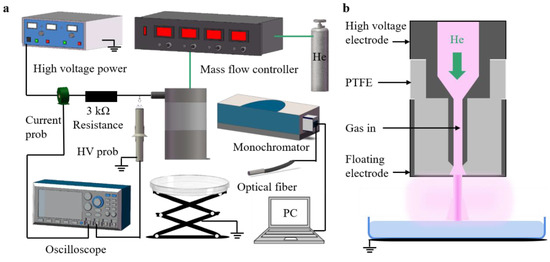
Figure 1.
Experiment setup of FEGLD plasma with (a) experiment schematic and (b) discharge reactor diagram.
3. Result and Discussion
3.1. Visualization Characteristics of FEGLD Plasma
Since the plasma and liquid surface interaction area could be varied by changing the discharge gap, Figure 2 shows the discharge images of FEGLD at the discharge gap of 10 mm, 13 mm, and 15 mm, captured by a Canon 550D digital camera with 500 ms exposure time, under the measurement conditions of 3.5 L/min gas flow rate and 30 kV pulse peak voltage. As Figure 2 shows, when the discharge gap is set at 10 mm, there is a discharge area over the liquid surface with the diameter larger than 20 mm, and no flames or unstable discharge model transition can be observed. In the middle of this, a mean discharge area has the most intense emission intensity. While enlarging the discharge gap distance from 10 mm to 15 mm, as shown in the figure, there is an obvious contraction in the discharge area over the liquid surface.

Figure 2.
Discharge images of FEGLD plasma with variations in the discharge gap.
3.2. Spectral Characteristics of FEGLD
The OES emitted from the FEGLD are illustrated in Figure 3, under the experimental conditions of 30 kV pulse peak voltage, 12 mm discharge gap, and 3.5 L/min gas flow rate. The OES of FEGLD is mainly composed of the second positive system of N2 (C3Πu→B3Πg), the first negative system (B2→X2), the bands of OH (A2Σ→X2Π), and the lines of He, Hα and O. The FEGLD is operated into open air filled with N2, O2, and H2O originating in liquid surface. In He discharge, the metastable helium is easily quenched by those molecules. These processes are shown as R(1)–R(3) in Table 1. While the pulse voltage is employed, the production of electrons via Penning ionization sustains the plasma between two discharge pulses [14]. The N2 (C) state could be produced by the ground state of nitrogen molecules N2 (X), as shown in R(4)–R(5). It should be mentioned that R(5) could release additional energy [18] contributing to temperature improvement as the gas fast heating mechanism. The first negative system (B2→X2) in FEGLD exhibited high emission intensity, as shown in Figure 3, the physicochemical process being shown in R6. Besides, the non-elastic collisions of the energetic electrons with N2, O2, and H2O molecules will induce its dissociation, excitation, and ionization [33]. The process of energetic electrons created by the discharge pulse colliding with O2 [34] is shown in R7. The physicochemical process of OH generation is shown in R8. Meanwhile, when the surrounding gas contains O2 and H2O, the collisional quenching of OH (A) by O2 is an important process, as shown in R9.
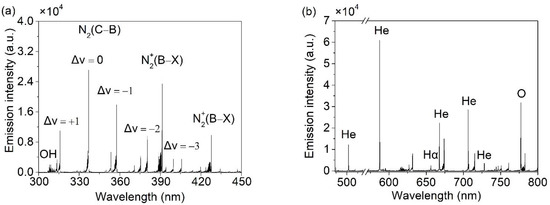
Figure 3.
Typical optical emission spectrum generated by FEGLD plasma in the wavelength range of (a) 300–450 nm and (b) 450–800 nm.

Table 1.
Related reactions for active species in FEGLD.
3.3. Electrical Characteristics of FEGLD
The distinction in discharge characteristics can be observed at pulse voltage duration times of positive and negative. Hence, the waveforms of the discharge current and topical voltage in positive pulse voltage and negative pulse voltage are presented in Figure 4a,b, under the experimental condition of 12 mm discharge gap, 30 kV pulse peak voltage, and 3.5 L/min gas flow rate. Figure 4a shows that the discharges mainly occur at the rising edge of positive pulse voltage, which has the rising time of about 250 ns. When the gas is broken down, one discharge current peak with 1.5 μs pulse width can be observed. In addition, three burr-like current peaks appear at the rising edge of the main discharge current peak. Each of those burr-like current peaks has the width of 50 ns. The characteristic of discharge current waveforms in negative pulse voltage is similar to that in positive pulse voltage, except their opposite polarity. In addition, there are a number of oscillations and a long plateau for voltage in each pulse. It is due to the power supply and capacitive loads in FEGLD that the charge accumulation at the plasma–liquid interface reduced the space charge loss, and sustained discharge [39].

Figure 4.
Typical discharge voltage and current waveforms for (a) positive pulse, and (b) negative pulse.
3.4. Gas Temperature of FEGLD
As a quantitative indicator, the gas temperature of FEGLD is acquired and discussed. Since the small energy gap between the rotational levels of the molecules, the translational–rotational equilibrium is readily achieved by frequent collisions between the heavy particles at AP [40]. The gas temperature can be considered approximately equal to the rotational temperature, and it can be acquired by analyzing the rotational spectra of excited molecular species [41,42]. In this work, the N2 (C3Πu → B3Πg, Δν = −2) is chosen to measure rotational temperature, because there is no overlap with OES emitting from He and other trace impurities originating from air, such as H and OH [43]. In this work, the Specair code [44] can be used to obtain the rotational temperature of N2 (C3Πu → B3Πg, Δν = −2) by comparing the simulated spectra and experimental spectra. As shown in Figure 5, under the experimental conditions of 3.5 L/min gas flow rate, 30 kV pulse peak voltage, and 12 mm discharge gap, the rotational temperature of N2 (C3Πu → B3Πg, Δν = −2) is 320 K, that is, close to the room temperature.
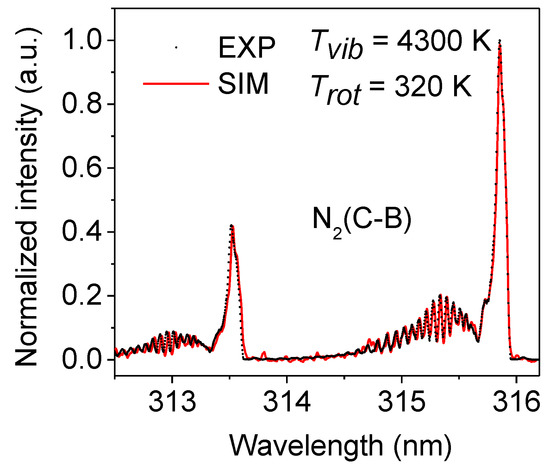
Figure 5.
The measured and the best-fitting simulation spectra of N2 (C3Πu → B3Πg, Δν = −2).
3.5. Electron Density of FEGLD
The hydrogen line broadening effects of electron density on Stark broadening is one of the most widely used techniques for electron density measurement [45]. Both Hα and Hβ could be used for the calculation. In this work, the Hα is preferred because of its high line shape sensitivity and adequate emission intensity. The emission line of Hα is the convolution of the Gaussian and Lorentzian lines. The Gaussian profile was determined by both the Doppler and instrument broadening, in which the fullwidth at half maximum (FWHM) of the Gaussian is given by:
where ΔλD and ΔλI are the FWHM of the Doppler broadening and instrumental broadening, respectively.
Doppler broadening mainly depends on the temperature of the emitter [46]. The FWHM of the Doppler broadening is given by the expression [47]:
where λ is the emission wavelength, Tg is the gas temperature of plasma in K and M is the atomic weight of hydrogen atoms in g·mol−1.
The broadening induced by the detection system is called apparatus function or instrumental broadening [41]. The instrument broadening in this work is determined by measuring the FWHM of the mercury lamp characteristic spectrum at 435.8 nm. Its value is given as:
while grating 1200 lines·mm−1 is used.
Lorentzian profiles are mainly determined by the Stark, van der Waals, resonance, and natural broadening, and the expression could be given by:
Natural broadening is caused by the uncertainty principle of atomic stable state energy, and the expression could be given by:
where Δ is uncertainty of the energy level, h is Planck constant, τ is energy level lifetime in the order of 10−9. The FWHM of natural broadening could be expressed as:
The value of natural line broadening is very small by calculation, in the orders of magnitude of 10−5 nm, which can be negligible in this study [48].
Resonance broadening occurs by electric dipole of the upper- or the lower-level transit to the ground state. The formula for the FWHM of resonance broadening could be written as follows [47,49]:
where λ is the wavelength of the spectral line, fr is the absorption oscillator strength, which is 0.6407 when the transition is 2s–3p for Hα line [50], λr is the wavelength of the resonance line; gk and gi are the statistical weights of its upper and lower levels, which are 8 and 18, respectively [49]. Ni is the ground state number density. Since FEGLD operated in the open air with low H2O concentration, the discharge happened on the liquid surface with low temperature, which is not enough to boil the water to improve the H2O concentration highly. The resonance broadening should be out of consideration in this work.
Van der Waals broadening is generated by collisions of excited H atoms with another kind of species, which is the helium atom in this work. An approximate formula for the FWHM of it is [51]:
where λ0 is wavelength, μ is the reduced mass, N is the neutral particle density, i is He and χ the fraction of the perturber. Hofmann et al. [51] calculated and reported the experiential expressions of the van der Waals broadening for different gas compositions at atmospheric pressure, and the formula can be shown as follows, where the C can be given when discharge plasma operates with different work gases.
In this work, the value of C is 2.42, which considers the plasma operating in air with helium as the work gas.
Stark broadening has high sensitivity to electron density. The relationship between the FWHM of the hydrogen alpha line and electron density is shown as follows [51]:
The line shapes of experimental and simulated Hα broadened by the above broadenings are shown in Figure 6. The values of FWHM for all the broadening mechanisms are presented in Table 2. The electron density is calculated to be about 2.2 × 1015 cm−3 under the conditions of 30 kV pulse peak voltage, 12 mm discharge gap, and 3.5 L/min gas flow rate.
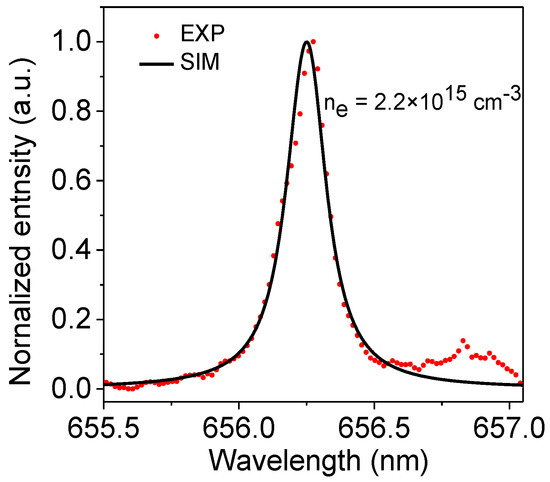
Figure 6.
Comparison of the experimental Hα line and simulated line.

Table 2.
Broadening of FEGLD plasma in Hα.
3.6. Spatial Distributions Characteristic of the FEGLD
For understanding the characteristic variation of discharge plasma in space, the spatially resolved emission intensity distributions of N2 (C3Πu → B3Πg), (B2Σ → X2Π), OH (A2Σ → X2Π), O (3p5P → 3s5S0), and He (3s3S → 2p3P0) of FEGLD are shown in Figure 7, under the experimental conditions of 12 mm discharge gap, 30 kV pulse peak voltage, and 3.5 L/min helium flow rate. In this part, the OES emitted from the different parts of FEGLD is obtained by optical fiber which is placed on the adjustable micrometer screw lifting platform.
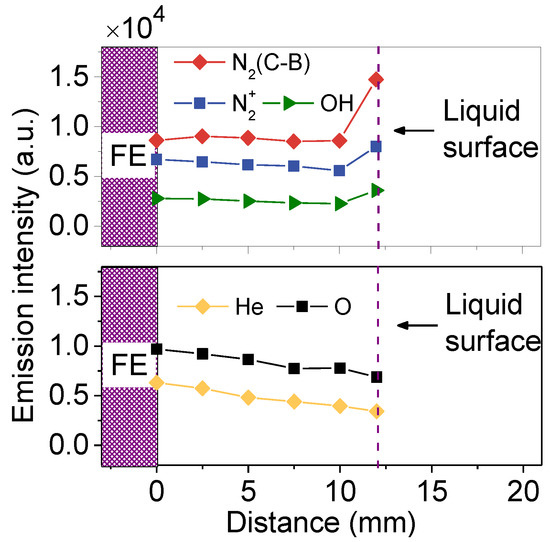
Figure 7.
The spatial distributions of N2 (C3Πu → B3Πg), (B2Σ → X2Π), OH (A2Σ → X2Π), O (3p5P → 3s5S0) and He (3s3S → 2p3P0) emission intensities.
The inconsistent spatial distributions of FEGLD reactive species emission intensities along the axial direction can be found in Figure 7. In the range of 0–10 mm, the emission intensities of N2 (C3Πu → B3Πg), (B2Σ → X2Π), and OH (A2Σ → X2Π) remains constant. But in the range of 10–12 mm which is near to the liquid surface, the emission intensities of (B2Σ → X2Π), N2 (C3Πu → B3Πg), and OH (A2Σ → X2Π) show obvious increases and attain a peak value at 12 mm. Meanwhile, the emission intensities of He (3s3S → 2p3P0) and O (3p5P → 3s5S0) keep decreasing in the range of 0–12 mm. This is because there are differences in the excitation mechanism of radiative states. The formation of He (3s3S → 2p3P0) and N2 (C3Πu → B3Πg) is dominated by direct excitation by energetic electrons [52], which relies on the high electric field and the electron density. But near the liquid surface, there is no obvious increase in electron density which is clearly shown in Figure 8. According to the research in [53], a mushroom-like shape discharge area is generated due to the interaction with a liquid surface. The N2 molecule from ambient air is involved in the discharge area. Thus, the emission intensity of N2 (C3Πu → B3Πg) increased here, and helium diffused here leading to the emission intensity of He (3s3S → 2p3P0) decreasing. The significant elevation of (B2Σ → X2Π) emission intensity comes from the Penning process [52], in which the increase of nitrogen will induce the improvement of (B2)u generation. The formation of OH (A) via direct dissociative electron excitation of water or dissociative recombination of H2O+ or H3O+ [54] The increase of OH (A2Σ → X2Π) emission intensity near the liquid surface is also shown in [52]. The H2O+(A) ion could exist in a mushroom-like shape area due to its relatively long radiative lifetime (about 10 µs), so the increase of OH (A2Σ → X2Π) emission intensity can be observed near the liquid surface.
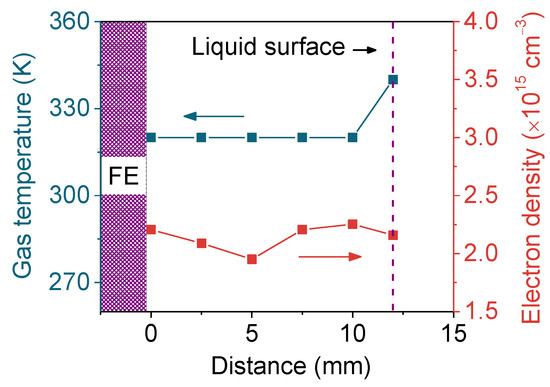
Figure 8.
Gas temperature and electron density distribution in the axial direction.
As the important parameters, gas temperature and electron density influence the gas–liquid discharge application. The spatially resolved gas temperature and electron density of FEGLD are shown in Figure 8 when the pulse peak voltage, gas flow rate, and discharge gap are kept at 30 kV, 3.5 L/min, and 12 mm, respectively. It clearly shows that the electron density remains at 2.2 × 1015 cm−3, almost without changes in the axial direction. The gas temperature remains at 320 K in the range of 1–12 mm, and reaches maxima of 340 K at 12 mm which is near the liquid surface. The increase in gas temperature near the liquid is also shown by Verreycken et al. [55] who attributed it to the fast vibration-to-vibration (V–V) process of O2–H2O and N2–H2O and, at the same time, H2O’s higher vibration-to-translation (V–T) rate compared to O2 and N2, which means that as the H2O concentration increases, additional gas heating occurs. One et al. [56] found that the temperature will be elevated while water vapor concentration increases. Moreover, since the inelastic collisions between electrons and heavy particles induce the plasma chemistry [57], which could be have potential applications in the treatment of living human and animal tissue [58], for instance, the high electron density plasma with approximately room temperature at AP is expected to meet temperature-sensitive needs.
3.7. The Effects of Discharge Gap on FEGLD
Considering the space compatibility during actual operation, the effect of the discharge gap on active species, the gas temperature, and the electron density are discussed. Figure 9 shows the effects of the discharge gap on the emission intensities of N2 (C3Πu → B3Πg), (B2Σ → X2Π), OH (A2Σ → X2Π), O (3p5P → 3s5S0), and He (3s3S → 2p3P0) of the FEGLD under the measurement condition of 30 kV plus peak voltage and 3.5 L/min gas flow rate. It clearly shows that the emission intensities of N2 (C3Πu → B3Πg), (B2Σ → X2Π), OH (A2Σ → X2Π), and O (3p5P → 3s5S0) remain almost constant as the discharge gap is enlarged from 10 mm to 15 mm. But in the same conditions, the emission intensity of He (3s3S → 2p3P0) decreases while the discharge gap changes from 10 mm to 13 mm. Since the emission spectrum of He (3s3S → 2p3P0) is an indicator of energetic electrons with relatively high threshold energy of 22.7 eV [59], the decrease of emission intensity of He (3s3S → 2p3P0) reflects the change in electron energy distribution, which is controlled by the applied reduced field E/N [60]. As the discharge gap is enlarged, the increase in the value of pressure multiplied by electrode gap distance led to the fall in the reduced electric field, which induces the energy of electrons to decrease [61], and then the emission intensity of He (3s3S → 2p3P0) is obviously decreased here.
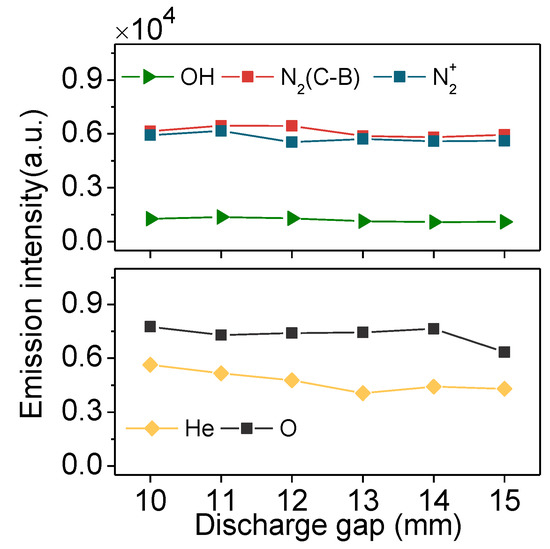
Figure 9.
Effects of the discharge gap on the emission intensities of N2 (C3Πu → B3Πg), (B2Σ → X2Π), OH (A2Σ → X2Π), O (3p5P → 3s5S0), and He (3s3S → 2p3P0).
The effects of the discharge gap on gas temperature and electron density of FEGLD are illustrated in Figure 10 under the measurement conditions of 30 kV plus peak voltage and 3.5 L/min gas flow rate. As shown in the figure, the electron density shows almost no change as the discharge gap increases. However, the gas temperature increased from 280 K to 350 K with the discharge gap elevated from 10 mm to 14 mm. Since the optical fiber is aimed at the medium area of FEGLD, it means this increase in gas temperature happened in the middle of the discharge plasma. Considering Figure 2, which shows clearly that the diameter of the discharge area near the liquid surface decreased with the discharge gap enlarging, the mushroom-like shape discharge, which is around the mean middle discharge, is not obvious. Therefore, the cooling effect is limited, which is expressly significant for the helium gas with high thermal conductivity at 1.6 × 103 J cm−1 s−1 K−1. Hence, in this work, the weakness of the cooling effect around the middle discharge area leads to the increase in gas temperature.
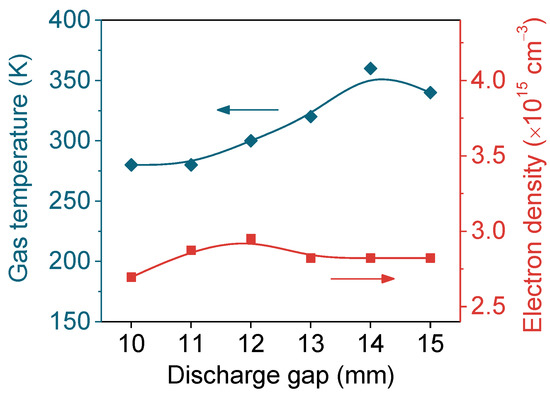
Figure 10.
Effects of the discharge gap on gas temperature and electron density.
3.8. The Effects of the Helium Flow Rate on FEGLD
Since the gas flow rate influences the time for gas stay, it further affects temperature transition and discharge characteristics. The effect of helium flow rate on the emission intensity of N2 (C3Πu → B3Πg), (B2Σ → X2Π), OH (A2Σ → X2Π), O (3p5P → 3s5S0), and He (3s3S → 2p3P0) are obtained and shown in Figure 11, under the experimental conditions of 12 mm discharge gap and 30 kV pulse peak voltage. It can be seen that as the gas flow rate is turned up, the emission intensities of (B2Σ → X2Π), He (3s3S → 2p3P0), and O (3p5P → 3s5S0) increased gradually. Meanwhile, the reduction in emission intensity of N2 (C3Πu → B3Πg) and OH (A2Σ → X2Π) can be observed. In the study by Yue et al. [62], OH distribution with different gas flow rates is reported. As the gas flow rate is increased, the OH distribution trends to uniform; meanwhile, the peak intensity value of OH-LIF is getting weaker. The influence of gas flow rate on O-LIF is also reported; it is due to the O (3p5P) having generated a relatively long lifetime of up to milliseconds [63] that the distribution of atoms could be influenced by gas flow. Similarly, as discussed before, the emission intensity of (B2Σ → X2Π) is dominated by the Penning process, and the metastable helium with long lifetime is driven by gas flow in the FEGLD, which leads to emission intensities of (B2Σ → X2Π) increasing.
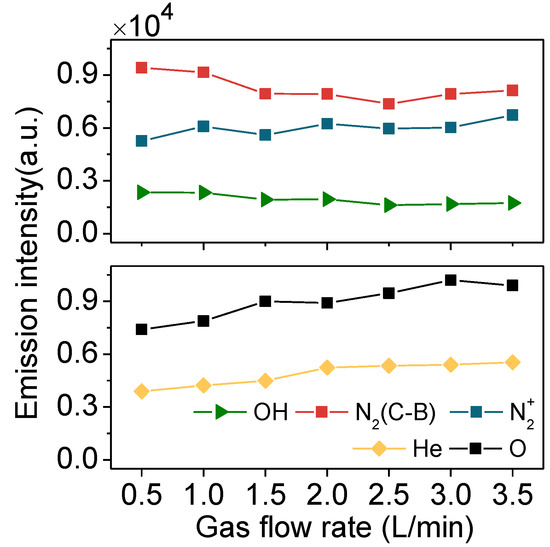
Figure 11.
Effects of helium flow rate on the emission intensity of N2 (C3Πu → B3Πg), (B2Σ → X2Π), OH (A2Σ → X2Π), O (3p5P → 3s5S0), and He (3s3S → 2p3P0).
The effects of gas flow rate on gas temperature and electron density are illustrated in Figure 12, where the pulse peak voltage and discharge gap are kept at 30 kV and 12 mm, respectively. It clearly shows that the gas temperature of FEGLD almost remains at 330 ± 10 K when the gas flow rate varied from 0.5 L/min to 3.5 L/min, suggesting that the FEGLD has good stability. The electron density increases obviously from 2.3 × 1015 cm−3 to 2.7 × 1015 cm−3, while the helium gas flow rate increased from 0.5 L/min to 3.5 L/min, which is the most obvious consistent improvement in this work. Since gas flow could promote collision processes [34], the reactions that could generate electrons are highly promoted by the increase in the gas flow rate. Meanwhile, the increase in high energy metastable helium amount is beneficial to generating the Penning process, which provides seed electrons for discharge. As the results show, increasing the gas flow can avoid gas heating and at the same time improve electron density and the capacity that generates reactive species such as O, which is one of the most important active species in plasma medicine applications [52]. This shows the potential for meeting the needs of such temperature-sensitive applications.
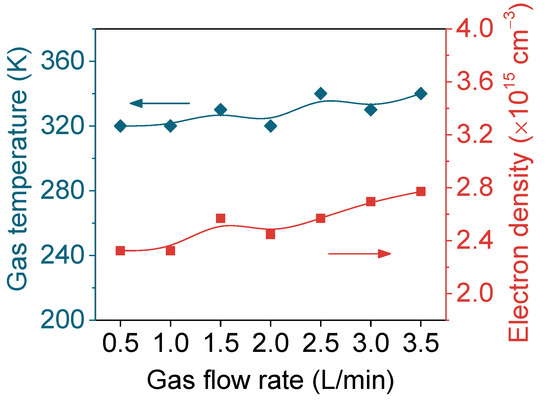
Figure 12.
Effects of gas flow rate on gas temperature and electron density.
4. Conclusions
In this paper, combined with nanosecond pulse voltage and a floating electrode, a stable gas–liquid discharge with electron density of 2.3 × 1015 cm−3 and low gas temperature of 320 K ± 20 K is obtained at AP. The OES spatial distributions show that gas temperature and emission intensities of N2 (C3Πu → B3Πg), (B2Σ → X2Π), and OH (A2Σ → X2Π) increase noticeably near the liquid surface. A large discharge area of 20 mm diameter is generated over the liquid surface when the discharge gap is set at 10 mm. As the discharge gap is increased further, obvious contraction is clearly shown in this area, with emission intensities of reactive species and electron density remaining constant. However, the electron density and emission intensity of reactive species such as O can be elevated by turning up the gas flow rate, whereas no obvious gas heating is observed.
Author Contributions
Investigation, M.Z.; Project administration, D.Y.; Supervision, Y.L. (Yunhu Liu), H.Y., J.L., Y.L. (Yao Li) and D.Y.; Writing—original draft, S.L.; Writing—review & editing, J.L. and D.Y. All authors have read and agreed to the published version of the manuscript.
Funding
This research was funded by [National Natural Science Foundations of China] grant number [11965018, 51977023 and 52077026], [Science and Technology Development Fund of Xinjiang Production and Construction] grant number [2019BC009], [Fundamental Research Funds for the Central Universities] grant number [DUT21LK31], [Key Laboratory Fund of National Defense Science and Technology] grant number [6142605200303], [Science and Technology Plan Project of the Ninth Division of the Crops] grant number [2021JS003].
Conflicts of Interest
The authors declare no conflict of interest.
References
- El Shaer, M.; Eldaly, M.; Heikal, G. Antibiotics Degradation and Bacteria Inactivation in Water by Cold Atmospheric Plasma Discharges Above and Below Water Surface. Plasma Chem. Plasma Process. 2020, 40, 971–983. [Google Scholar] [CrossRef]
- Gururani, P.; Bhatnagar, P.; Bisht, B. Cold plasma technology: Advanced and sustainable approach for wastewater treatment. Environ. Sci. Pollut. Res. Int. 2021, 28, 65062–65082. [Google Scholar] [CrossRef] [PubMed]
- Yang, D.Z.; Zhou, X.F.; Liang, J.P. Degradation of methylene blue in liquid using high-voltage pulsed discharge plasma synergizing iron-based catalyst-activated persulfate. J. Phys. D Appl. Phys. 2021, 54, 244002. [Google Scholar] [CrossRef]
- Laroussi, M.; Bekeschus, S.; Keidar, M. Low-Temperature Plasma for Biology, Hygiene, and Medicine: Perspective and Roadmap. IEEE Trans. Radiat. Plasma Med. Sci. 2022, 6, 127–157. [Google Scholar] [CrossRef]
- Qin, H.; Qiu, H.; He, S.T. Efficient disinfection of SARS-CoV-2-like coronavirus, pseudotyped SARS-CoV-2 and other coronaviruses using cold plasma induces spike protein damage. J. Hazard. Mater. 2022, 430, 128414. [Google Scholar] [CrossRef] [PubMed]
- Busco, G.; Robert, E.; Chettouh-Hammas, N. The emerging potential of cold atmospheric plasma in skin biology. Free Radic. Biol. Med. 2020, 161, 290–304. [Google Scholar] [CrossRef]
- Lu, Q.F.; Li, J.L.; Yu, J. Preparation of Ta2O5 nanoparticles by using cathode glow discharge electrolysis. Mater. Res. Express. 2021, 8, 125011. [Google Scholar] [CrossRef]
- Sirotkin, N.A.; Khlyustova, A.V.; Titov, V.A. The Use of a Novel Three-Electrode Impulse Underwater Discharge for the Synthesis of W-Mo Mixed Oxide Nanocomposites. Plasma Chem. Plasma Process. 2021, 42, 191–209. [Google Scholar] [CrossRef]
- Wang, H.; Xu, Q.; Zhou, X. Highly efficient adsorptive removal of persistent organic pollutants using NPD-acid combined modified NaY zeolites. Chem. Eng. J. 2022, 431, 133858. [Google Scholar] [CrossRef]
- Liu, W.; Bao, Y.; Duan, X. Study on water treatment effect of dispersion discharge plasma based on flowing water film electrode. Plasma Sci. Technol. 2021, 23, 105502. [Google Scholar] [CrossRef]
- Zhou, R.; Liu, B.; Li, Y. Reduced breakdown voltage for in-liquid plasma discharges using moveable electrodes. J. Phys. D Appl. Phys. 2021, 55, 10LT01. [Google Scholar] [CrossRef]
- Liang, J.; Zhou, X.; Zhao, Z. Discharge characteristics and reactive species production of unipolar and bipolar nanosecond pulsed gas–liquid discharge generated in atmospheric N2. Plasma Sci. Technol. 2021, 23, 095405. [Google Scholar] [CrossRef]
- Szulc, M.; Forster, G.; Marques-Lopez, J.L. Influence of Pulse Amplitude and Frequency on Plasma Properties of a Pulsed Low-Current High-Voltage Discharge Operated at Atmospheric Pressure. Appl. Sci. 2022, 12, 6580. [Google Scholar] [CrossRef]
- Liang, J.; Zhou, X.; Zhao, Z. Reactive oxygen and nitrogen species in Ar + N2 + O2 atmospheric-pressure nanosecond pulsed plasmas in contact with liquid. Phys. Plasmas 2019, 26, 023521. [Google Scholar] [CrossRef]
- Korolev, Y.D.; Frants, O.B.; Landl, N.V. Features of a near-cathode region in a gliding arc discharge in air flow. Plasma Sources Sci. Technol. 2014, 23, 54016. [Google Scholar] [CrossRef]
- Baeva, M.; Loffhagen, D.; Becker, M.M. Fluid Modelling of DC Argon Microplasmas: Effects of the Electron Transport Description. Plasma Chem. Plasma Process. 2019, 39, 949–968. [Google Scholar] [CrossRef]
- Rousso, A.C.; Goldberg, B.M.; Chen, T.Y. Time and space resolved diagnostics for plasma thermal-chemical instability of fuel oxidation in nanosecond plasma discharges. Plasma Sources Sci. Technol. 2020, 29, 105012. [Google Scholar] [CrossRef]
- Saifutdinov, A.I. Unified simulation of different modes in atmospheric pressure DC discharges in nitrogen. J. Appl. Phys. 2021, 129, 093302. [Google Scholar] [CrossRef]
- Bruggeman, P.J.; Iza, F.; Brandenburg, R. Foundations of atmospheric pressure non-equilibrium plasmas. Plasma Sources Sci. Technol. 2017, 26, 123002. [Google Scholar] [CrossRef]
- Bruggeman, P.J.; Frontiera, R.R.; Kortshagen, U.R. Plasma-driven solution electrolysis. J. Appl. Phys. 2021, 129, 200902. [Google Scholar] [CrossRef]
- Yang, D.Z.; Jia, L.; Wang, W.C. Atmospheric Pressure Gas-Liquid Diffuse Nanosecond Pulse Discharge Used for Sterilization in Sewage. Plasma Process Polym. 2014, 11, 842–849. [Google Scholar] [CrossRef]
- Yuan, H.; Yang, D.; Jia, Z. Activated Carbon Modified by Nanosecond Pulsed Discharge for Polycyclic Aromatic Hydrocarbons Detection. Plasma Chem. Plasma Process. 2020, 40, 1539–1553. [Google Scholar] [CrossRef]
- Herrmann, A.; Margot, J.; Hamdan, A. Influence of voltage and gap distance on the dynamics of the ionization front, plasma dots, produced by nanosecond pulsed discharges at water surface. Plasma Sources Sci. Technol. 2022, 31, 045006. [Google Scholar] [CrossRef]
- Gromov, M.; Leonova, K.; Britun, N. Plasma nitrogen fixation in the presence of a liquid interface: Role of OH radicals. React. Chem. Eng. 2022, 7, 1047–1052. [Google Scholar] [CrossRef]
- Xu, H.; Liu, D.; Xia, W. Comparison between the water activation effects by pulsed and sinusoidal helium plasma jets. Phys. Plasmas 2018, 25, 013520. [Google Scholar] [CrossRef]
- Wang, S.; Yang, D.; Liu, F. Spectroscopic study of bipolar nanosecond pulse gas-liquid discharge in atmospheric argon. Plasma Sci. Technol. 2018, 20, 075404. [Google Scholar] [CrossRef]
- Wang, S.; Yang, D.Z.; Zhou, R. Mode transition and plasma characteristics of nanosecond pulse gas–liquid discharge: Effect of grounding configuration. Plasma Process Polym. 2019, 17, 1900146. [Google Scholar] [CrossRef]
- Divya Deepak, G. Review on recent advances in cold plasma technology. Eur. Phys. J. Appl. Phys. 2022, 97, 39. [Google Scholar] [CrossRef]
- Zhu, T.; Liu, J.; Xin, Y. Hydrogen production by microwave discharge in liquid: Study on the characteristics effect of suspended electrode. J. Anal. Appl. Pyrolysis 2022, 164, 164. [Google Scholar] [CrossRef]
- Hu, W.; Wang, J.; Xu, W. Electrical and Optical Characteristics of a Color Alternating Current Plasma Display Panel With Floating Electrodes. J. Disp. Technol. 2013, 9, 100–105. [Google Scholar] [CrossRef]
- Lee, H.W.; Nam, S.H.; Mohamed, A.-A.H. Atmospheric Pressure Plasma Jet Composed of Three Electrodes: Application to Tooth Bleaching. Plasma Process Polym. 2010, 7, 274–280. [Google Scholar] [CrossRef]
- Liu, W.; Ma, C.; Li, Z. Generation of atmospheric-pressure homogeneous dielectric barrier discharge in air. EPL Europhys. Lett. 2017, 118, 45001. [Google Scholar] [CrossRef]
- Liu, Z.J.; Wang, W.C.; Zhang, S. Optical study of a diffuse bipolar nanosecond pulsed dielectric barrier discharge with different dielectric thicknesses in air. Eur. Phys. J. D 2012, 66, 319. [Google Scholar] [CrossRef]
- Eichwal, O. Coupling of chemical kinetics, gas dynamics, and charged particle kinetics models for the analysis of NO reduction from flue gases. J. Appl. Phycol. 1997, 82, 4781–4794. [Google Scholar] [CrossRef]
- Yang, D.; Wang, W.; Wang, K. Spatially resolved spectra of excited particles in homogeneous dielectric barrier discharge in helium at atmospheric pressure. Spectrochim. Acta A 2010, 76, 224–229. [Google Scholar] [CrossRef]
- Niemi, K.; Waskoenig, J.; Sadeghi, N. The role of helium metastable states in radio-frequency driven helium–oxygen atmospheric pressure plasma jets: Measurement and numerical simulation. Plasma Sources Sci. Technol. 2011, 20, 055005. [Google Scholar] [CrossRef]
- Liu, Y.; Liu, D.; Zhang, J. 1D fluid model of RF-excited cold atmospheric plasmas in helium with air gas impurities. Phys. Plasmas 2020, 27, 043512. [Google Scholar] [CrossRef]
- Kovačević, V.V.; Dojčinović, B.P.; Jović, M. Measurement of reactive species generated by dielectric barrier discharge in direct contact with water in different atmospheres. J. Phys. D Appl. Phys. 2017, 50, 155205. [Google Scholar] [CrossRef]
- Lai, J.; Foster, J.E. Time-resolved imaging of streamer formation inside gaseous bubbles in liquids. J. Phys. D Appl. Phys. 2020, 53, 025206. [Google Scholar] [CrossRef]
- Luo, S.; Denning, C.M.; Scharer, J.E. Laser-rf creation and diagnostics of seeded atmospheric pressure air and nitrogen plasmas. J. Appl. Phys. 2008, 104, 013301. [Google Scholar] [CrossRef] [Green Version]
- Bruggeman, P.J.; Sadeghi, N.; Schram, D.C. Gas temperature determination from rotational lines in non-equilibrium plasmas: A review. Plasma Sources Sci. Technol. 2014, 23, 023001. [Google Scholar] [CrossRef]
- Zhang, L.; Yang, D.; Wang, W. Needle-array to Plate DBD Plasma Using Sine AC and Nanosecond Pulse Excitations for Purpose of Improving Indoor Air Quality. Sci. Rep. 2016, 6, 25242. [Google Scholar] [CrossRef] [PubMed]
- Wang, Q.; Koleva, I.; Donnelly, V.M. Spatially resolved diagnostics of an atmospheric pressure direct current helium microplasma. J. Phys. D Appl. Phys. 2005, 38, 1690–1697. [Google Scholar] [CrossRef]
- Laux, C.O. Optical diagnostics of atmospheric pressure air plasmas. Plasma Sources Sci. Technol. 2003, 12, 125–138. [Google Scholar] [CrossRef]
- Nikiforov, A.Y.; Leys, C.; Gonzalez, M.A. Electron density measurement in atmospheric pressure plasma jets: Stark broadening of hydrogenated and non-hydrogenated lines. Plasma Sources Sci. Technol. 2015, 24, 015015. [Google Scholar] [CrossRef]
- Gigosos, M.A.; González, M.Á.; Cardeñoso, V.n. Computer simulated Balmer-alpha, -beta and -gamma Stark line profiles for non-equilibrium plasmas diagnostics. Sci. Rep. 2003, 58, 1489–1504. [Google Scholar] [CrossRef]
- Djurović, S.; Konjević, N. On the use of non-hydrogenic spectral lines for low electron density and high pressure plasma diagnostics. Plasma Sources Sci. Technol. 2009, 18, 035011. [Google Scholar] [CrossRef]
- Qian, M.; Ren, C.; Wang, D. Stark broadening measurement of the electron density in an atmospheric pressure argon plasma jet with double-power electrodes. J. Appl. Phys. 2010, 107, 063303. [Google Scholar] [CrossRef]
- Adams, N.G.; Bhatia, A.K.; Amusia, M.Y.; Louck, D.J.; Jud, R.B.; Paldus, J.; Hill, N.R.; Gallagher, A.; Fischer, F.C.; Grant, P.I.; et al. Springer Hand Book of Atomic Molecular, and Optical Physics; Drake, G.W.F., Ed.; Drake Springer Science+Business Media, Inc.: New York, NY, USA, 2006; ISBN 978-3-030-73892-1. [Google Scholar]
- Cox, A.N.; Däppen, W.; Cowley, C.; Wiese, L.W.; Fuhr, J.; Kuznetsova, A.L.; Keady, J.J.; Kilcrease, D.P.; Hjellming, M.R.; Tokunaga, A.T.; et al. Allen Astrophysical Quantities; Springer: New York, NY, USA, 1999; ISBN 978-1-4612-1186-0. [Google Scholar]
- Hofmann, S.; van Gessel, A.F.H.; Verreycken, T. Power dissipation, gas temperatures and electron densities of cold atmospheric pressure helium and argon RF plasma jets. Plasma Sources Sci. Technol. 2011, 20, 065. [Google Scholar] [CrossRef]
- Sretenovic, G.B.; Krstic, I.B.; Kovacevic, V.V. Spectroscopic Study of Low-Frequency Helium DBD Plasma Jet. IEEE Trans. Plasma Sci. 2012, 40, 2870–2878. [Google Scholar] [CrossRef]
- Kovačević, V.V.; Sretenović, G.B.; Slikboer, E. The effect of liquid target on a nonthermal plasma jet—imaging, electric fields visualization of gas flow and optical emission spectroscopy. J. Phys. D Appl. Phys. 2018, 51, 065202. [Google Scholar] [CrossRef]
- Bruggeman, P.; Iza, F.; Guns, P. Electronic quenching of OH(A) by water in atmospheric pressure plasmas and its influence on the gas temperature determination by OH(A–X) emission. Plasma Sources Sci. Technol. 2010, 19, 015016. [Google Scholar] [CrossRef]
- Verreycken, T.; van Gessel, A.F.H.; Pageau, A. Validation of gas temperature measurements by OES in an atmospheric air glow discharge with water electrode using Rayleigh scattering. Plasma Sources Sci. Technol. 2011, 20, 024002. [Google Scholar] [CrossRef]
- Ono, R.; Teramoto, Y.; Oda, T. Effect of humidity on gas temperature in the afterglow of pulsed positive corona discharge. Plasma Sources Sci. Technol. 2010, 19, 015009. [Google Scholar] [CrossRef]
- Tendero, C.; Tixier, C.; Tristant, P. Atmospheric pressure plasmas: A review. Sci. Rep. 2006, 61, 2–30. [Google Scholar] [CrossRef]
- Fridman, G.; Peddinghaus, M.; Balasubramanian, M. Blood Coagulation and Living Tissue Sterilization by Floating-Electrode Dielectric Barrier Discharge in Air. Plasma Chem. Plasma Process. 2006, 26, 425–442. [Google Scholar] [CrossRef]
- Walsh, J.L.; Iza, F.; Janson, N.B. Three distinct modes in a cold atmospheric pressure plasma jet. J. Phys. D Appl. Phys. 2010, 43, 075201. [Google Scholar] [CrossRef]
- Lepikhin, N.D.; Luggenhölscher, D.; Czarnetzki, U. Electric field measurements in a He:N2 nanosecond pulsed discharge with sub-ns time resolution. J. Phys. D Appl. Phys. 2021, 54, 055201. [Google Scholar] [CrossRef]
- Wang, S.; Wang, W.C.; Yang, D.Z. Optical and application study of gas-liquid discharge excited by bipolar nanosecond pulse in atmospheric air. Spectrochim. Acta A 2014, 131, 571–576. [Google Scholar] [CrossRef] [PubMed]
- Yue, Y.; Pei, X.; Gidon, D. Investigation of plasma dynamics and spatially varying O and OH concentrations in atmospheric pressure plasma jets impinging on glass, water and metal substrates. Plasma Sources Sci. Technol. 2018, 27, 064001. [Google Scholar] [CrossRef]
- Iseki, S.; Ohta, T.; Aomatsu, A. Rapid inactivation of Penicillium digitatum spores using high-density nonequilibrium atmospheric pressure plasma. Appl. Phys. Lett. 2010, 96, 153704. [Google Scholar] [CrossRef] [PubMed] [Green Version]
Publisher’s Note: MDPI stays neutral with regard to jurisdictional claims in published maps and institutional affiliations. |
© 2022 by the authors. Licensee MDPI, Basel, Switzerland. This article is an open access article distributed under the terms and conditions of the Creative Commons Attribution (CC BY) license (https://creativecommons.org/licenses/by/4.0/).